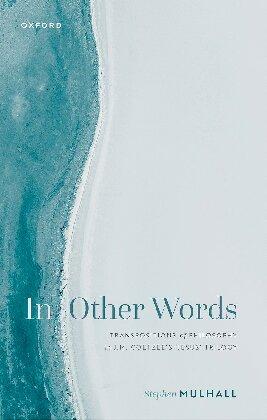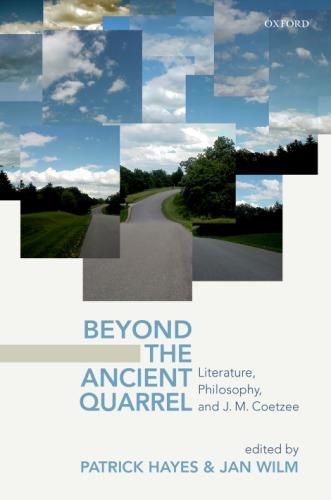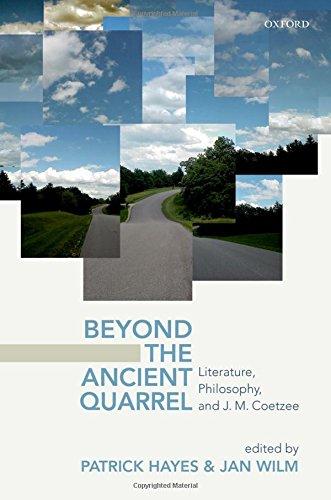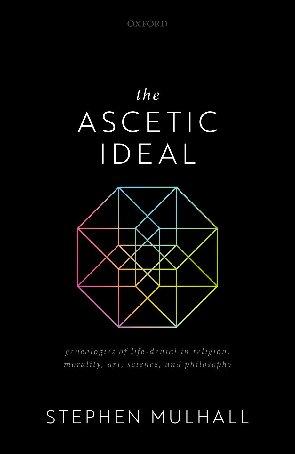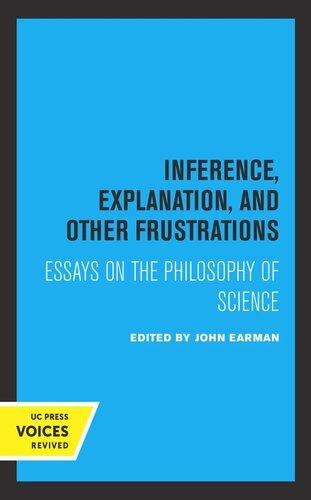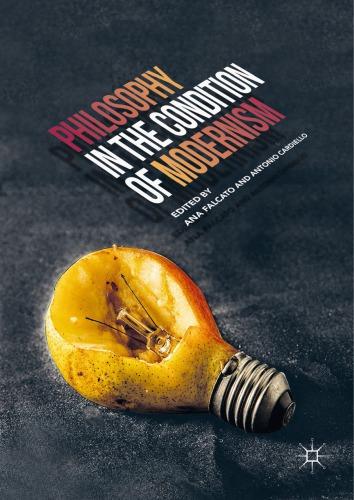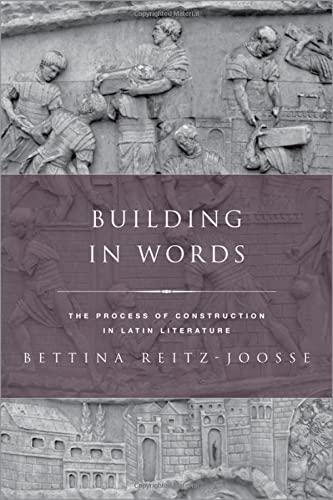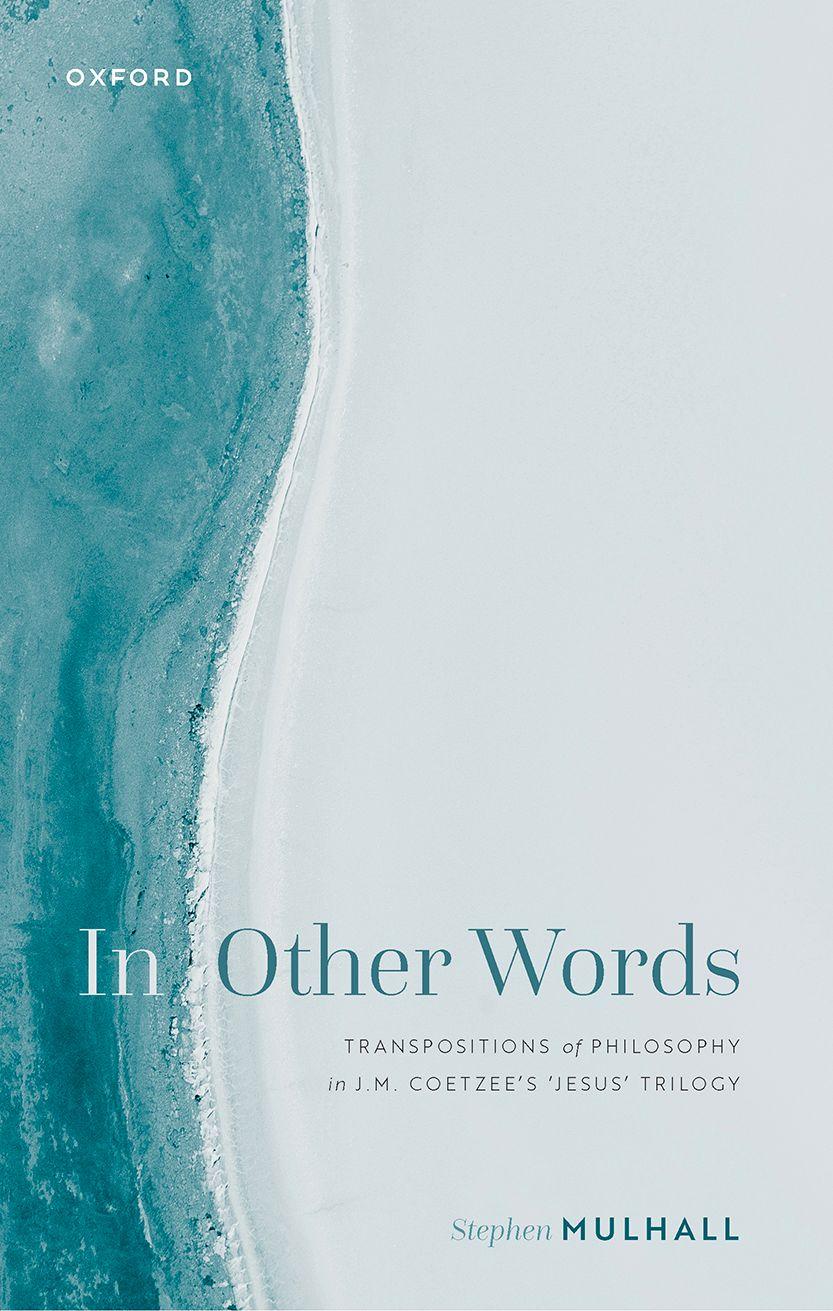Introduction
J.M.Coetzee’ s ‘Jesus’ trilogybeginswiththearrivaloftwodisplaced persons ayoungboyandhisadultcompanionandprotector atthe resettlementcampofacitycalledNovilla.¹Neitherrememberstheirlives priortotheseavoyagetothisnewlandduringwhichtheymet;likeevery otherinhabitantofit,²theirmemorieshavebeenwipedcleanoftheir personalhistory,althoughtheyrememberhavinghadsuchhistories,and soknowthatthereissomethingtheydon’torcan’trememberabout themselves.Attheendoftheirvoyage,theyweredepositedatacoastal towncalledBelstar,andheldatareceptioncampforseveralweeks, duringwhichtheywereassignednames(DavidandSimón,respectively) andapproximateofficialages(fiveandforty-five,respectively),andwere taughtSpanish(thelanguageoftheirnewcountry).Whentheyarriveat Novilla,seekingaplacetoliveandameansofearningaliving,Simón describeshimselfasDavid’sfather,althoughthereisnobiologicalor legalrelationshipbetweenthem;andhequicklyembarksonanother quest to findDavid’smother,ormoreprecisely,to findamotherfor David.NeitherofthemknowsthenameofDavid’srealmother,oreven whethershehasalsotravelledtothisland aletterbelongingtoDavid thatmighthaveheldanswerstothesequestionswaslostonboardtheir ship;butSimónisconvincedthatheorDavidwillrecognizeherimmediatelywhentheyseeher.Andsoonafterestablishingthemselvesin Novilla,theyencounterawomanwhostirsanobscuresenseoffamiliarityinSimónwhensheoffersDavidafriendlygreeting.Heatonce arrangesameetingwithher,andaskshertotakeDavidasherson;and
¹Thetrilogycomprises TheChildhoodofJesus (London:HarvillSecker,2013), The SchooldaysofJesus (London:HarvillSecker,2016),and TheDeathofJesus (Melbourne:Text Publishing,2019):hereafter ‘CJ’ , ‘SJ’,and ‘DJ’,respectively.
²Coetzee’stextneitheraffirmsnorexcludesthepossibilityofnewinhabitantsbeingborn there.
InOtherWords:TranspositionsofPhilosophyinJ.M.Coetzee’s ‘Jesus’ Trilogy.StephenMulhall, OxfordUniversityPress.©StephenMulhall2022.DOI:10.1093/oso/9780192869715.003.0001
afterastartlinglybriefperiodofreflection,she(Inés)agreestodoso. TheirsharedtaskofcaringforandeducatingDavid firstinNovillaand thenforalongerperiodoftimeinanother,moreremotetowncalled Estrella constitutesthecoreoftheensuingnarrative.
Thiscombinationofcollectivememorylossandtheconstructionofa familyonthebasisofintuitionandsheerwillhardlysoundslikethe premiseofanexercisein fictionalrealism;andasweshallsee,other aspectsofthebasicshapeand finerdetailsoflifeinthislandthatare disclosedasDavid’snewlyconstituted ‘family’ settleintoitdiverge equallysharplyfromthosegoverningoureverydayexistence.That said,weshouldn’tdenytheclear(ifnon-linear)correspondences betweenthis fictionalworldofdisplacedpeople,resettlementcamps, anderasedpersonalhistoryandthetreatmentofmigrantsinourcontemporaryworld(inAustralia,whereCoetzeecurrentlylives,butalsoon theMediterraneanbordersofEurope,thesouthernbordersoftheUnited States,thesouthcoastoftheUnitedKingdom,andelsewhere).³And thereisadifferencebetweencategorizingatextasagenericexercisein literaryrealismandclaimingitasonecomposedinwhatonemightcalla realisticspirit inwhicharelationtoliteraryrealismismaintainedby radicallyinterrogatingitsgenericconventions.Thisisthesubjectofan explicitdiscussioninoneofCoetzee’searlier fictions, ElizabethCostello; ⁴ andinearlierworkofmineonthattext,Iunderlinedthefactthatthat discussiondevelopsanunderstandingofrealismthatpivotsonadistinctionbetweenembeddingandembodying,aroundwhichCostello (herselfanovelist)andhernarratororganizetheirthinkingabouthow therealisticimpulse findsexpressioninmodernistliterature.⁵ Because thiscommentarygrowsoutofthatearlierwork,andassumesasignificantdegreeofcontinuityofconcernsbetween ElizabethCostello and the ‘Jesus’ trilogy,abriefrecountingofthemainelementsofthat ³SomethingemphasizedbyTimMehiganinhisarticle ‘Coetzee’ s TheChildhoodofJesus and theMoralImageoftheWorld’ (inRutherfordandUhlmann[eds], J.M.Coetzee’sThe ChildhoodofJesus:TheEthicsofIdeasandThings [London:Bloomsbury,2017]).
⁴ London:SeckerandWarburg,2003 hereafter ‘EC’
⁵ SeeChapter11ofmy TheWoundedAnimal:J.M.CoetzeeandtheDifficultyofRealityin LiteratureandPhilosophy (PrincetonN.J.:PrincetonUniversityPress,2009).
understandingofrealismmightprovidethereaderwithsomehelpful preliminaryorientation.⁶
Inthe firstchapterorlessonof ElizabethCostello,theprotagonist’ sson Johnobjectstoherearlieruseofthecategoryofrealisminalecture, whichbeganbyproclaimingthedeathofrealismasaviableliterary enterpriseandyetclaimedasanexemplaryexerciseinrealismKafka’ s shortstoryaboutanapenamedRedPeter,whodeliversareporttoan academyabouthisexperiencesasananimalforciblyinductedinto WesternEuropeansociety.
‘WhenIthinkofrealism’,hegoeson, ‘Ithinkofpeasantsfrozenin blocksofice.IthinkofNorwegiansinsmellyunderwear...people pickingtheirnoses.Youdon’twriteaboutthatkindofthing.Kafka didn’twriteaboutit.’ ‘No,Kafkadidn’twriteaboutpeoplepickingtheirnoses.ButKafka hadtimetowonderwhereandhowhispooreducatedapewasgoingto findamate.Andwhatitwasgoingtobelikewhenhewasleftinthe darkwiththebewildered,half-tamedfemalethathiskeeperseventually producedforhisuse.Kafka’sapeisembeddedinlife.Itistheembeddednessthatisimportant,notthelifeitself.Hisapeisembeddedaswe areembedded,youinme,Iinyou.Thatapeisfollowedthroughtothe end,tothebitter,unsayableend,whetherornottherearetraceslefton thepage.Kafkastaysawakeduringthegapswhenwearesleeping,that iswhereKafka fitsin.’ (EC,32)
Kafka’sapeisnotinarealisticsituation;norealapehasbeen,or(we think)couldpossiblybeeducatedtotheculturallevelofanaverage European.Nevertheless,havingembeddedhisapeinEuropeanculture, Kafkadevelopsitsconsequenceswitharigorousattentiontothereal natureoftheapeandoftheculturehe(impossibly)inhabits.Arealape willhavesexualandemotionalneeds;realhumanbeingswouldtryto
⁶ Thepresentworkhasalsobeeninfluenced,althoughlessdirectly,byaninterpretationof Coetzee’sautobiographicaltrilogy(aswellasofhiswritingsonthetheoryandpracticeoflifewriting)thatislaidoutinEssayTwoofmy TheAsceticIdeal (OUP,2021),entitled ‘Writingthe LifeoftheMind’
satisfythem,inordertomaintaintheirprofits,andwouldcarelittle aboutthesanityofthematetheyprocure,orthepotentiallymonstrous consequencesoftheircongress.Costelloisineffectarguingthatevena talewhichtakesitsstartingpointfromasheerimpossibility(beyond anythingtobeencounteredinreality)mightneverthelesscountasa contributiontotheprojectofliteraryrealism,insofarasthedevelopment ofthattalecanbeseenasalogicallyandemotionallyrigorousunfolding oftheconsequencesofthatunintelligibleorigin anunsentimental articulationofwhattheimpossibleembeddingofonerealityintoanother mightrevealaboutboth.
Costello’snotionofembeddingisitselfembeddedinacontextthat associatesitwithtwoothernotions,whichtogetherimpartareflexive aspecttothediscussion confirmingoursensethat,asherson’ squestionpresupposes,herdescriptionofKafka’srealismisalsoaselfdescription.First,shecomparesRedPeter’sembeddednessinlifewith herson’sembeddednessinherandhersinherson.Thefamiliarcomparisonofliterarycreativitywithhumanprocreationistherebygivena particulartwist:forinsofarasbothCostelloandhersonfunctionasthe termanalogoustolifeontheapesideofthemetaphoricalequation,it suggeststhatthe fictionalcreationendowsitscreatorwithlifeasmuchas thecreatorhercreation.Butwhenviewedfromthevantagepointofthe ‘Jesus’ trilogyanditsco-createdunrealfamily,afurtherimplication becomessalient:thatbothchildrenandparentsconstitutetheprimary structuresofrealityforeachother,andinthatsenseembedeachother inlife.
ThesecondnotionCostelloassociateswithrealismisthatofKafkaas stayingawakewhenwearesleeping.Thispartlyspecifieshersenseofthe realistauthorashavingacommitmenttotherealanditsineluctable consequencesthatmosthumanbeingsmostofthetimecanneither desirenorbear;butitalsoinvokesacanonicalculturalimageof philosophy thatofSocratesstillawake,whenalltheotherwinersand dinershavecollapsedintounconsciousness,asdawnbreaksattheendof Plato’ s Symposium.Asweshallsee,Costello’ssenseofliterature’ s uncannyintimacywithphilosophy,sharingitsinterestinmoraledificationandinagenuineapprehensionofthereal(astheformatofalesson, withitssuggestionoftakinginstruction,alreadyimplies), findsastrong
andpersistentechointhe ‘Jesus’ trilogy,andnotsolelybecauseofPlato’ s insistentpresencewithinit.
Bylinkingtogetherorconstellatingthesethreenotions(embedding, pro/creativity,andwakefulness),Costellooffersusawayofunderstandingherownmostfamous fictionasanexpressionofwhatIwouldcall modernistrealism.That fictionisentitled TheHouseonEcclesStreet,and amountstoarecreationofJoyce’sMollyBloom;andCostellodeclares thatherattempttomakesomethingnewfromthematerialleftoverfrom Joyce’sprodigalinventivenesswasitselfconditionedbyadesireto relocateMollyfromJoyce’srealisticallyimaginedbedroom(‘withthe bedwiththecreakingsprings’)totherealsightsandsmellsofthestreets ofDublinin1904,aswellastheparticularculturalpossibilitiesactually opentoMollyandLeopoldalikeatthathistoricalmoment.Otherwise put:sheshowedhowJoyce’sliberationofthesensualrealityofwomen fromitspriorliteraryconfinementwasitselfconfined,thatMollycould ‘equallywellbeanintelligentwomanwithaninterestinmusicanda circleoffriendsofherownandadaughterwithwhomsheshared confidences’ (EC,14).
Onemight,therefore,saythatCostelloplaysoffonekindofembeddednessagainstanother:byexploitingtheindebtednessofanyliterary creationtoitsantecedents,shetriestoembedthewholly fictionalandyet vitallyrealMollymoredeeplyintonon-fictionalhumanreality.Shetries tostayawakeduringthegapswhenJoycewassleeping orrather,she bringsustoseehisapparentlyseamlesscreation(itssuccessfulcreation ofanimpressionofrealfemalenessinhisMolly)asactuallyhavinggaps inthelightofherown,apparentlymoresuccessful, fictionalrepresentationofrealfemaleness.Insofarasaprior fictionalrepresentationhasany realitytoit insofarasitaspiresto,oranywaysucceedsin,apprehending somethingaboutreality thenattendingproperlytoitinallits fictionality,evenifthatprocesstakestheformofcreatinganother fiction,may neverthelessbringusclosertowhatisreal.
WhereCostellochoosestheterm ‘embedding’,hernarratorultimately arrivesattheterm ‘embodying’,atleastwhendiscussingthediscomfort createdforliteraryrealismbyideas achallengethatisevenmore pertinentforthe ‘Jesus’ trilogy(withitsunendingsequencesofconversationsabouthowbesttocomprehendeverythingfromhumanwasteto
themusicofthespheres)thanitisfor ElizabethCostello.Moreprecisely, Coetzee’snarratortalkstwiceoftherelationbetweenhisenterpriseand morefamiliarmodesofrealism,withthe firstsuchdisquisitionsetting thestageforthesecond’sfocusonembodiment.Thisinitialstage-setting comesafteraparagraphwhichdescribesCostello’sappearanceinthe kindofpared-downwaythatwillbecome(sometimeswearyingly)familiartoanyreaderofthe ‘Jesus’ trilogy:
Thebluecostume,thegreasyhair,aredetails,signsofamoderate realism.Supplytheparticulars,allowthesignificationstoemergeof themselves.AprocedurepioneeredbyDanielDefoe.RobinsonCrusoe, castuponthebeach,looksaroundforhisshipmates.Butthereare none. ‘Ineversawthemafterwards,oranysignofthem,’ sayshe, ‘exceptthreeoftheirhats,onecap,andtwoshoesthatwerenot fellows.’ Twoshoes,notfellows:bynotbeingfellows,theshoeshave ceasedtobefootwearandbecomeproofsofdeath,tornbythefoaming seasoffthefeetofdrowningmenandtossedashore.Nolargewords, nodespair,justhatsandcapsandshoes.(EC,4)
Ontheonehand,Coetzeeisassociatinghisenterprisewiththatof Defoe’splainlydenotativerealism:supplysomesmallandplainparticularsandthesignificationswillemergebythemselves.Ontheotherhand, heisalsodissociatinghimselffromDefoe’sprolixity hissensethatan unendingprofusionofsuchplainparticularsisessentialiftheillusionof realityistobesuccessfullycreated.ForwhereRobinsonCrusoe’slifeis conjuredfromavastterrainoftextualdetailconcerninghislifeonthe island,ElizabethCostellocomestolifeforus(ifshedoes)froma comparativelymeagrediet:thecolourofherclothesandthegreasiness ofherhairconstituteCoetzee’sentireexpenditureofparticularityupon her.ThisideaofmoderationwouldseemexiguouseventoDefoe’ s Puritanismofprose.
Moreover,thetextinwhichorfromwhichCostelloemergesisfurther attenuatedbyaseriesofinterruptions.Onekindisintroducedbymaking referencetoscenesthattakeplaceintheworldofthestory,butwhichare notsimplyomittedbutpositivelyskipped,bymeansofasentencewhich describesthespeechactitisperforming: ‘Thereisasceneinthe
restaurant,mainlydialogue,whichwewillskip.Weresumebackatthe hotel... ’ (EC,7).Anotherinvolvesthecreationofagapinthenarrative, whichisrepresentednotbyaliteralgapbutbytheinsertionofthewords themselves(‘Agap’ [EC,27,28])betweentwosentencesthatarestraightforwardlypartofthenarrative.Asweshallsee,thisideaofgapsor breaks,cracksorholes,inanaccountwillrecurinthe ‘Jesus’ trilogy;but in ElizabethCostello theiroccurrenceneversucceedsindissolvingour interestinCostelloandhervicissitudes.Wemightwellwonderwhat kindofhavocanauthorhastocreatetostopusreceivingandretaining animpressionofreality,fromwhichotherliteraryeffectscanthenbe generated.
InthespecificcaseofDefoe,forexample,evenhisexemplaryrestrictionofhisprosetothebarestofbaredenotationdoesnotpreventthe efflorescenceof figurativesignificance.Forwhen(inthepassage Coetzee’snarratorcites)hesaysthatthetwoshoeswerenotfellows,he meansthattheydonotformapairwitheachother,buthealsothereby invokesthetwodistinctfellowhumanbeingsfromwhomthoseshoes weretorn.Hismeaningoutrunsitsliteralbounds,andtherebyexemplifieslanguage’srefusaltorestrictitselftothepurelyorabsolutelyliteral itsrevelationofthetrueemptinessorirrealityofanysuchnotionof literality.AndbychoosingjusttheseparticularsfromDefoe’stext, CoetzeeappearstoendorseCostello’sclaimthatrealismofthefamiliar, Defoe-likekindhasitselfsufferedshipwreck thatindividualelements ofitstextualconstructionsmightbereclaimedandembodiedinnew reconstructions,butthecentralillusiononwhichitisbasedhasbeen shattered,andsocanonlysurviveinaradicallyrevisedform(suchas Kafka’s,suchasCostello’s,suchasCoetzee’s).Andyet,readerscontinue tobelieveinthedrowningmenandthefoamingseas,inthenovelistand hersonarguingaboutliterature;evenwhentheselinesfromCrusoeare quotedinanotherstoryaltogether,thelostsailorsreviveinourimaginations,justasCostellotakeslifethroughtheperfunctorynotationofher bluedressandgreasyhair.Evenhere,then,wehavenotyetreacheda conventionalminimumbelowwhichtheimpressionofrealitysimply willnotbeconveyed,willceasetotakeonformandbodyinourminds. Theseconddisquisitionaboutrealismpicksupandinflectsthisideaof embodiment,justafterthenarrator’saccountofaconversationbetween
JohnandanothercharacternamedWheatleyaboutthenotionofliterary merit:
Realismhasneverbeencomfortablewithideas.Itcouldnotbeotherwise:realismispremisedontheideathatideashavenoautonomous existence,canexistonlyinthings.Sowhenitneedstodebateideas,as here,realismisdriventoinventsituations walksinthecountryside, conversations inwhichcharactersgivevoicetocontendingideasand therebyinacertainsenseembodythem.Thenotionof embodying turnsouttobepivotal.Insuchdebatesideasdonotandindeedcannot floatfree:theyaretiedtothespeakersbywhomtheyareenounced,and generatedfromthematrixofindividualinterestsoutofwhichtheir speakersactintheworld forinstance,theson’sconcernthathis mothernotbetreatedasaMickeyMousepost-colonialwriter,or Wheatley’sconcernnottoseemanold-fashionedabsolutist.(EC,9)
WhereCostelloseesembeddednessaspivotalforrealismafterthe shipwreckofrealism,Coetzee’snarratorprivilegesembodiedness. Coetzeetakesthepremisethatideascannot floatfreefromtheindividualswhoarticulatethem(apremisethatPlato’schoiceofdialogueform appearstoacknowledge,evenifsomanyofhisdialoguesvariouslyaspire toreorientourattentiontoarealmofpureideasorforms),andthen pushesitfurther,byemphasizingtheirrootednessintheanimalityofthe humananimal,its fleshandbloodandallthatitgeneratesorengenders. Heliteralizestherealistideaofembodiedness seestheconcretereality oflivinghumanbodiesandfreightsimagesofthehumanbodyinallits concretenesswitharangeofmoreorlessabstract,obscure,andultimatelyunsynthesizedsignifications.Andheclaimsthatthisishowrealism canandmustaccommodateideas thatthisiswhatitistotreatthemin arealisticspirit.
Thatisnotthesameasbeingcomfortablewiththem:butperhaps discomfortwithideasispreciselywhattheirrealnaturedemands.For Coetzee’spointispreciselythatideasdiscomfortus:theydemanda degreeofabstractionfromrealitywhichchallengesus,althoughina waythatwe asgenuinelyrationalanimals cannotdismiss;andtheir fleshlyorigins theirrootednessintheparticularitiesofindividual
cultures,minds,andbodies revoltus,astheyrevoltedPlatoandcontinuetorevoltthephilosopherineveryrationalanimal,atleastsomeof thetime.Accordingly,anymodeofrealismthatengageswithideasmust dosoinawaythatembodiesthatverydiscomfort,andsotransmitsitto itsreaders.Itaccordinglycannotavoidrunningtheriskofformal shipwreck inthecaseofthistext,byradicallyattenuatingconcrete descriptivedetail,leavinggapsandskippingscenes,andinterrupting itselfwithreflectionsontheseaspectsofitself.Ittherebyembodiesa modeofevaluatingideasthatrunscontrarytooursensethatsuch evaluationcanonlytaketheformofimpersonal,internallycoherent linesofargumentandcriticismthatresultindefinitiveconclusionsof universalapplication.
Thattherearesucharguments,andthattheyareworthyofrespect,is nottobedenied;butallsuchargumentsarealsoembeddedorembodied inavarietyofwaystowhichtheyshouldnotbereduced,butbywhich theyaresignificantlyconditioned,andoftenintangled,mutuallyconflictingwayswhichcomplicateevaluationtothepointofputtingdefinitiveconclusionsbeyondourreach askingofusawillingnessto contemplateorsufferthedifficultyratherthanattemptingtosolveor resolveit.Todenytherelevanceofsuchembeddednesstoanyassessmentofthesignificanceoflinesofreasoningandtheideastheysupport wouldbeasunrealisticastoreducesuchassessmenttoanexclusive concernwiththeirvariousembodiments.Itisnothardtoseewhysucha conclusionisonewithwhichphilosophymightwellbediscomfited.
Isaidearlierthatthislessonfrom ElizabethCostello pivotsona distinctionbetween ‘embedding’ and ‘embodying’;butaproperlyrealistictreatmentoftheirroleinthattextwouldhavetoacknowledgetheir relatednessaswellastheirseparateness.Inthetermsthetextitself provides,arealistictreatmentoftheseideasofembeddingandembodyingmustcertainlyacknowledgetheirtiestothespeakerswhoenounce them,whichmeansacknowledgingthespecificdifferencesbetween Costello’smatrixofindividualinterestsandthatofhernarrator.Butit mustalsoallowroomfortherevelatorypossibilitiesofimpossibleconjunctions;andthatmeansacceptingnotonlythatacharacterina fiction andthenarratorofthat fictionmightneverthelessconversewithone another(forexampleaboutrealism)butthattheirinterlocutory
perspectivesonthattopicmightbeconvergent,eachenrichingthe other’sgrasponitssubject.
Weshouldthereforethinkof ‘embedding’ and ‘embodying’ asinflectionsofeachother:ascloseasthespellingsofthewordsembodyingthese ideas,asdifferentasthespeakersintowhoseactionstheyareembedded. Andwemightthenconsiderpicturingthegeneralrelationbetweenideas andrealityinthetermsprovidedbytheimpossibleconjunctionofthese particularideas namely,asamatterofembedding-as-embodiment,or embodiment-as-embedding.Forifideasmustbeembodiedinthings, andyetcanalsobeembeddedinotherthings(callthemcontexts),then theymustbecapableofbeingextractedfromanyoftheirparticular embodiments;soeveryembodimentofanideaisanembeddingofit, whichmeansthatnoideaisfullyabsorbedintoanyofitspossible embodiments,andnoembodimentisreducibletoitsabilitytoincorporateagiven(rangeof)ideas.Thiswouldbearealisticacknowledgement ofthediscomfortingwayinwhichideasandrealitydependupon,and areindependentof,eachother.
Sincetextsareonekindofcontext,and ‘embodyingasembedding’ is theconjunctionoftwospecificideas,itwouldonlyberealisticto acknowledgethattheytoocanbeextractedfromtheparticulartextin whichwe firstencounterthemandembeddedinothertexts(particularly thosecreatedlaterbythesameauthor).Butitwouldbeunrealisticto expectthemsimplytoreappearintheiroriginalguiseinthoselater texts evenwhensuchatextisalsoconcernedwithideasandtheir relationtoreality,andsowithphilosophyanditsrelationtoliterature. Foreachnewcontextwillinflectthoseideasdifferently,bringingout previouslyoccludedaspectsordimensionsoftheirsignificanceand occludingpreviouslysalientones,andtherebyenrichingtheirmeaning aswellasdisplayingmeaningingeneralasalways-already-to-beunfolded.Andtheclaimaroundwhichthisreadingofthe ‘Jesus’ trilogy willpivotisthattheideaaroundwhichitpivots,andwhichconstitutes itsprimarylineofcontinuitywith ElizabethCostello’spivotalidea(s),is thatof ‘translation’.Inotherwords, ‘translation’ iswhatbecomesof ‘embodyingasembedding’ whenitisembeddedintoandembodiedby the ‘Jesus’ trilogy. ‘Translation’ isanotherwordfor ‘embodyingas embedding’;itiswhatresultswhen ‘embodyingasembedding’ is
translatedfromitsoriginaldiscursivecontextintothediscursivecontext ofthesethree fictions.Andthisactoftranslation(Coetzee’s,andthe threeattemptstocharacterizeitsnaturethatIjustformulatedand ordered)bringsoutparticularaspectsordimensionsofthesignificance ofallthreeideas,aswellasofthebroaderdiscursive fieldswhichare therebybroughtintoconjunction.
Thetaskofsupplyingamoresubstantialanddetailedgroundingfor thisclaimwilloccupymelater;butafewsketched-inpointswill,Ihope, sufficetogiveitsomeinitialplausibility.Tobeginwith,Simónand David likemostoftheinhabitantsoftheirnewland havetolearn Spanishbeforetheycanberesettled;andthisfundamentalfactabout theirexiledstate,aswellastheirprogressinmeetingthechallengeit poses,isunderlinedbythepersistentappearanceinthetextofuntranslatedSpanishwordsandphrases(whichreproduceforanglophone monolingualreadersaveryminimalversionofthediscomfortfeltby thenarrative’sprotagonists).TwoshortpassagesofGermanpoetry, recitedbyDavid,alsocropupearlyandlateinthenarrative:noexplanationfortheirpresenceisoffered,buttheyarealsountranslated,and(for thoseequippedtorecognizethis)significantlydistortedfromtheir originals.
Thespecificallyartisticdimensionofthistrafficbetweenlanguages, cultures,andhistoricalerasisepitomizedinthesolepieceofliterature DavidandSimónencounterduringtheirresidence:acopyofCervantes’ DonQuixote,butinanillustratedchildren’sedition(hencepresumably bothabridgedandbowdlerized,andcertainlyassubjecttodistortionas theGermantexts).GivenitsSpanishprovenance,ourencounterswith extendedquotationsfromthattextforcefullyremindthereaderthatthe wholeoflifeinthislandisconductedinthatlanguage,andsoleaveus uncertainexactlyhowmuchofthe fictionwearereadingistobe understoodasatranslationintoEnglish(ifthatisthecasewiththe Cervantesadaptation,thenitwillbetrueofmuchofthereportedspeech, andmightevenbetrueofincreasingportionsofthetext’sreportsof Simón’sinteriormonologues).
ButtherelationbetweentheCervantesadaptationanditsoriginal merelyexemplifiesthefactthattranslationisanontologicalprincipleof this fictionalworldmoregenerally.Mostobviously,itcharacterizesthe
relationbetweentheoldlifeofthosewhotraveltothislandandtheirnew lifeinit:tocallthemdisplacedorresettledisjustanotherwayofsaying thattheyhavebeentranslatedfromonelifetoanother.Despitehaving theirmemoriesoftheirpastlifewipedaway,theyknowthattheyhad anotherlife,andtheyknowthatthenewlifetheycurrentlyleadis neverthelessledbythesamepersonwholedthatoldlife.Inthisrespect, theiridentityorintegrityasindividualshasmysteriouslybutundeniably survivedtheirdisplacementfromonemodeorkindofexistenceto another justasDonQuixotelivesoninthechildren’seditionof Cervantes’ work,andthesenseofCervantes’ wordsisheldtosurvive itstranspositionintolanguagesotherthanhisoriginalSpanish.
Conjoiningquestionsaboutidentityoflinguisticmeaning(andits distinctivemodesofdistortion,attenuation,orloss)withquestions aboutidentityof fictionalcharactersandrealpersons(eachwiththeir distinctiveformsoffailure)mightseemundulyforced.Soit’sworth pointingoutthatwedon’tneedtothinkofthatconjunctionasitselfan identityrelation(atleast,notifwethinkofidentityrelationsasabsolutelybinary,asifallsuchrelationsareessentiallymathematical):it mightratherbethateachisbetterunderstoodasatranslationofthe other.Inwhichcase,itmightalsohelptonotethattheprimarymeaning oftheword ‘translation’ (accordingtotheOED)isreligiousratherthan linguistic,andhastodowiththetranspositionordisplacementof persons understoodbothasoccupantsofspecificrolesoroffices,and asexistingbeyondsuchinstitutionalconstraints.Bishopsandministers aretranslatedfromoneseeorparishtoanother;theremainsofsaintsare translatedfromonelocationtoanother(moreappropriate)one;and humanbeingsaretranslatedfromearthlyexistencetoaheavenlyone.If anything,then,ourconceptionsofcontinuityofsenseacrosslinguistic boundaries(whichunderpinourveryideaofidentityofmeaning,andso oftranslation)are etymologicallyspeaking translationsofacomplex, context-sensitiveconstellationofthewaysinwhichhumanidentity survivestranspositionfromonemetaphysicalcontextorconditionto another(orfailsto).
Thisbringsustoanothertranslationissue:theroleandsignificanceof thename ‘Jesus’ inthetitles,butnotthe fictionalworld(s),ofthesethree lateCoetzeetexts.Ononelevel,itisaperfectlycommon firstnamein
Spanish-speakingcultures;onanother,itisnowindissociablyrelatedto anabsolutelysingularoruniqueperson JesusChrist,theincarnate deityoftheChristianreligion,andsothebeinginwhomtheprinciples ofembeddingandembodying(ofthedivineinthehuman)impossibly coincide.AlthoughnooneinCoetzee’snarrativeisnamed ‘Jesus’,the onlypersonwhosechildhood,schooling,anddeathisrecountedinthat narrativeisDavid,andhisreal(thatis,non-assigned)nameremains unknowntotheend.Anddespitethethoroughgoingabsenceofreligious practicesorinstitutionsinthisnewland,somanyelementsoftheGospel stories,andtheirbroaderbiblicalcontexts,showupinthesetexts (variouslyaltered,transposed,anddisplaced)thatCoetzee’sreadersare forcedtoaskwhetherinsomewaythistrilogymightormustbe understoodasatranslationofthatChristiannarrative inparticular, whetherDavid,Simón,andInésshouldbeseenasanembodimentofthe HolyFamily,oranembeddingofthathighlyunorthodoxtrinity(virginal mother,adoptivefather,anddivineson)intoaresolutelysecularform oflife.
Iftherelationbetweenthesetextsandtheirtitlespresentsitselfasa translationissue,(particularlyinsofaras ‘translation’ isseenasacontinuationoftheideaof ‘embodyingasembedding’),thenthesamemight besaidoftherelationbetweenthethreetextsthatmakeupthistrilogy. Onthelevelofnarrativestructure,whilstthe firstvolumerecountswhat resultsfromembeddingDavidandSimónintothepeculiarcontextof Novilla,thesecondandthirdvolumestracktheprocessoftheirtranslationfromNovillatoEstrella(anotherpeculiartown,butwithitsown distinctiveidiosyncrasies,amongstwhichisthefactthatitsnamemodulatesfromthemorediminutive ‘Estrellita’ withoutexplanationbetween the firstvolumeanditssuccessors).Andatthelevelofthematicand conceptualcontinuity,thereaderisoftenbroughttofeelthatideas introduced(sometimesverybriefly)inearlypartsofthetrilogyreappear embeddedinnewcontexts,wheretheyacquire(sometimesradically) modifiedmeaning,andthatthisprocessofrepeatedtranslationisa primarymotorofthetrilogy’sdevelopment.It’sasifthetext’sexpansion isfundamentallydrivennotbyindividualpsychologyandcharacter,and notbythemomentumofunfoldingevents,butbythedesiretoelicit furthersignificancefromasmallnumberofthemesbyconstructing
moreorlessextremevariationsuponthem(oftenbymeansofdifferent interweavingsofthem)whichneverquitelosecontactwiththeiroriginal forms.
One final,muchmoreexternalorbiographical,pointmighthelpto reinforcethetenabilityofmyclaimthatthenotionof ‘translation’ isat theheartofthe ‘Jesus’ trilogy.Thepracticeoftranslationhasalwaysbeen apartofCoetzee’sartisticrepertoire,andhehasalwaysshowngreat interestinhowhisworksarethemselvestranslated.Inrecentyears, however,hehasalsoshownanincreasingdisenchantmentwiththe globalhegemonyofAmericanandBritishculture,andanincreasing desiretoengagewithwhatmightbecalled ‘LiteraturesoftheSouth’ in waysthatarenotthemselvesdeterminedbytheculturalgatekeepersof themetropolesoftheNorth.⁷ Thatiswhyhehasrecentlydirecteda seminarserieswiththattitleattheNationalUniversityofGeneralSan Martín,inGreaterBuenosAires,towhichhehasinvitedwritersfrom AustraliaandSouthernAfrica.Againstthisbackground,itisperhaps unsurprisingthatarecentbookofhis(acollectionofseventales)has appearedinSpanishtranslation(underthetitle Sietecuentosmorales),as wellasinItalian,French,andJapanese,withnopublicationinEnglish currentlyplanned.Butitwasstillstartling(atleasttothismetropolitan gatekeeper)todiscoverthatthe finalvolumeofthe ‘Jesus’ trilogywas first publishedinSpanishtranslation(as LaMuertedeJesús),somesix monthsbeforetheEnglishoriginal firstappearedinAustralia,withthe USandUKpublicationfollowingsomemonthslater.Insuchcircumstances,isitstillentirelyuncontroversialtoviewthetext’spublicationin Englishasthemomentwhentheoriginaltext finallyappeared?However thatmaybe,CoetzeeplainlywenttosomelengthstocreatetheimpressionamongstthoseintheAnglo-Americanculturalworldthatthe EnglisheditionwassomehowabelatedtranslationoftheSpanishedition,andtherebytogiveusthefaintest flavourofwhatitwaslikefor Simónwhenhe firststeppedoffhisship.
⁷ ThispointiselaboratedinDerekAttridge, ‘TheSouthAccordingtoCoetzee’,in Public Books,25September2019(https://www.publicbooks.org/the-south-according-to-coetzee).
NOVILLA
TheDeviantPupil
IsuggestedatseveralpointsintheIntroductionthatthe ‘Jesus’ trilogy maintainsCoetzee’slong-establishedinterestinphilosophy,andinthe often-fraughtrelationsbetweenphilosophyandliterature.Ialsoclaimed that,in ElizabethCostello,thatinterest findsexpressioninitsexploration oftwomorespecificquestions:thewayinphilosophyandliteraturetreat thequestionoftherelationbetweenideasandreality,andthewayin whichphilosophy’sdrivetoapprehendtherealitybeneathorbeyond appearances findsitsliterarycounterpart(anditscompetitor)inwhat Icalledmodernistrealism.Thisinterest findsaratherdifferent,andyet notunrelated,modeofexpressioninthe ‘Jesus’ trilogy:throughoutits firstvolume, TheChildhoodofJesus,whichcoversthefullperiodoftime David’sfamilyspendinNovilla,particularphilosophicaltextsprovide veryexplicitpointsofreferencetowhichCoetzee’stextrepeatedly returns,andinrelationtowhichitseekstoprovideasustainedresponse. Ishallconcentrateontwo Plato’ s Republic¹(whosepresenceishardto miss),andWittgenstein’ s PhilosophicalInvestigations²(whosepresence israthereasiertooverlook).Theformerisembodiedinthecontextinto whichDavidandSimónhavebeentranslated,whilstthelatterfundamentallyshapeswhattheirjointpresenceembedsintothatcontext. However,itwillalsobecomeclearthatthesignificanceoftheorientation
¹Trans.D.Lee(London:Penguin,1987).
²Revised4theditionbyHackerandSchulte,trans.Anscombe,Hacker,andSchulte(Oxford: Blackwell,2009) hereafterPI.
InOtherWords:TranspositionsofPhilosophyinJ.M.Coetzee’s ‘Jesus’ Trilogy.StephenMulhall, OxfordUniversityPress.©StephenMulhall2022.DOI:10.1093/oso/9780192869715.003.0002
theyprovide(bothsinglyandinimpossibleconjunction)isinseparable fromtherelationinwhichtheystandtotwoothertexts: DonQuixote³ andtheBible.
1.TheJustCity
ThecityofNovillaisinfusedby ‘thespiritoftheagora’ (CJ,115), manifestinarangeofPlatonicformsandcontent.Simónhasseveral philosophicaldialogueswiththecity’sresidents:Anadisputestheconnectionbetweenbeauty,goodness,andsexualdesire(CJ,30–2);Elena arguesthatdesireisonlyasourceofendlessdissatisfaction(CJ,63);and thestevedoreswithwhomSimónworksaredevoteesofphilosophy classesabouthowideasengenderunityinthemidstofdiversity for example,howindividualchairsparticipateinchairness,andsoamount toembodimentsorrealizationsoftheideaorformofachair(CJ, 119–22).
Simónrepeatedlyresortstothisimageoftheroleofideas,thereby unifyingadiversityofconcretecontexts.HetellsDavidthatAna’ s referencetothebodilymechanicsofsexualintercoursereallyconcerned thewayonemindmightforceideasuponanother(CJ,34);thenhe invertstheimagewithElena,arguingthatthemotherprovidesthe materialsubstanceofachildwhilstthefathermerelyprovidestheidea, therebypresentingsexualintercourseasoneconcreterealizationof reality’sparticipationinideas(CJ,104).Andagainstthestevedores,he arguesthatwithoutideastherewouldbenouniversebecausethere wouldbenobeing(CJ,115).Bythis,heprimarilymeansthatthere wouldbenounifiedworldofdistinguishableexistentthings;butsincehis preferredexampleofanideaisthatofjustice,healsoinvokestheinternal relationofideasandideals modelsforhowacurrentlyunsatisfactory worldmightbemadeotherwise,broughtclosertoitsdistinctivetelos, andsotoitself.Butinvokingjustice,understoodasanaspirationto realizeaworldinwhichhonesttoilbringsduereward,pointsusmore
³ByMigueldeCervantes,trans.C.Jarvis(Oxford:OxfordUniversityPress,1992) hereafterDQ.
specificallytowardsPlato’ s Republic anditsinitiatingdefinitionofjustice asamatterofgivingeachpersonwhatisduetothem.
AndNovilla’swayoflifedoesindeedappeartoembodytheideallyjust citythatSocratesbuildsoutofhisconversationalexchangeswith AdeimantusandGlaucon.Itsinhabitantshappilyendorsethe Republic’sadvocacyofradicalsexualequality(askedwhethershehasa maninherlife,Elenasaysthatshehasbothmaleandfemalefriendsand doesn’tdistinguishbetweenthem[CJ,55]),andthelooseningofparent–childbonds(Elenacarefullydistinguishesbiologicalfromemotional parenting,arguingthatthelattermattersmostandthatbothmenand womenareequippedtoprovideit,therebyimplyingthatSocrates’ envisagedseparationofchildrenfromtheirbiologicalparentsisaperfectlyreasonableproposal[CJ,104]).Moregenerally,Novilla’sinhabitantshaveestablishedaregimeinwhichhumandesiresare firmlyunder thecontrolofreason aworldfromwhichstormsofpassion(whether aboutsexoraboutfood)havebeenexiled.
ThisiswhatmostdisturbsSimón,whoyearnsforsexualintimacyand foramorevaried,spicydietideallyinvolvingtheconsumptionofjuicy animal flesh.ButifherejectsthestricturesofthisPlatonicUtopia,why doesheresortsopersistentlytooneofthecentralmetaphysicaldoctrines underpinningit?CoetzeanrealismasIhavedefineditrequiresusto relatetheseideastotheirembodyingcontexts whichinthiscaseare conversationswithinhabitantsofNovilla,inwhichSimón’sprimary concernisnottodeclareanddefendhisrealbeliefsbuttofurtherhis owninterestsinthefaceofhisinterlocutors’ hostilityorincomprehensionbydeployingtheirownideasagainstthem.Withthestevedores,he wantstoliberatehimselffromburdensomemanuallabour;withElena, heisdefendinghisdecisiontohandoverDavidtoInés;andwithDavid, heisattemptingtomaskAna’sshamingexposureofhissexualdesigns onherbyrecharacterizingthemintermsthatthechildwillhaveto masterifheisevertobecomeproperlynativetoNovilla.Inotherwords, thecontextualembodimentsofthesePlatonicideasasSimonenounces themturnthemtoprofoundlyun-Platonic evensophistical purposes. It’salsoworthaskingjusthowPlatonictheUtopiaembodiedby Novillareallyis.AlthoughPlatoandSocratesbothadvocatereason’ s masteryoverdesire,Novilla’srepressionofbodilysatisfactionsgoesfar
beyondthatrequiredbyeither.SodoesCoetzee’sportrayalofNovillaas anembodimentofPlatonicidealsdoPlatoaninjustice,offeringcaricature ratherthansatire(whatonemightcall rememberingDavid’sdelightin watchingatelevisioncartooninvolvingananimalcharacterhecalls ‘Plato’ ratherthanPluto aMickeyMouseversionofphilosophy’ s founder)?Ifso,thentheun-PlatonicusestowhichSimónputsNovilla’ s beliefsystemoffernocriticalpurchaseontherealPlato.
Thereis,however,apointinthe Republic atwhichsocial(andso psychic)arrangementsofthekindenforcedinNovillaareexplicitly articulated,onlytobeapparentlyrejectedinfavourofamoresophisticatedlevelofhumanself-cultivation.ThisisatthebeginningofbookII, afterThrasymachus’ departure,butbeforethefullcomplexityofthe internaleconomyofSocrates’ justcity andinparticular,itsneedfora guardianclassfromwhomthephilosopherkingswillultimatelyevolve hasbeenarticulated.Wemightcallthisagapduringwhichmanyof Plato’sreadersfallasleep.
WhenSocratesaskshowhumansocietyarises,hisanswerinvokes mutualneed(thefactthathumansarenotindividuallyself-sufficient) anddifferencesofaptitude,whichgenerateamodeofcommunallifethat dividesitsmembersinto fiveclasses:producers,merchants,sailors,retail tradersandmanuallabourers.Suchasocietyrequiresabareminimum ofclothing,equallysimplefood(suchasbarley-meal,beans,nutsand vegetables)andbasicformsofshelterandfurnishing;anditscitizenslead apeacefulandhealthyexistence,attainaripeoldage,andbequeaththe sameformoflifetotheirchildren.ButGlauconimmediatelycallsthis acommunityofpigs,lackingallordinarycomforts:Socratescallsthem rathertheluxuriesofcivilization.Hereiteratesthatthissocietyisthetrue oneforhumanbeings, ‘likeamaninhealth’,whereasGlaucon’scivilized societyis ‘oneinafever’;butheacknowledgesthatstudyingthelatter mightbejustifiedbecauseinthatnewcontextitmightbeeasierto discover ‘howjusticeandinjusticearebredinacommunity’ (R,368–73).
ThispassageimpliesthatwhatmostviewasSocrates’ idealcity(the Utopiaelaborateduponintherestofthedialogue)isinfacthisvisionof adiseasedconditionofsocietyanditscitizens.ThetrueSocraticUtopia istobefoundinthe firsthalfofBookII:becauseitisinternally articulated,itisapossiblematrixofjustice,insofarasjusticeis as
SocratesandAdeimantusnote amatteroftheproperrelationship betweenitselements;butbecausethatarticulationissosimpleand transparent,becauseitisinherentlystableandtransmissiblebetween generations,justiceisnotacomplicatedchallengebutsomethingselfevidenttoall.Theissuebecomesbewilderingonlywhenoursociety’ s internalcomplexityexpandstoengenderandsatisfydesiresthatgo beyondlife’snecessaries aworldconsistingofthoseconcernedwith domesticconsumption(especiallywomen’sdressandmake-up);of hunters, fishermen,swineherdsandcattle-herders;andofartists.
So,Coetzee’sdepictionofNovillamightreallybeanaccurateportrayal oftheUtopiathatPlatoandSocratesadvocate,andSimónmightreally beacriticofphilosophy’sfoundingideal.Exceptforonething the distinguishingformofPlatonicphilosophicalprose:irony.Novilla’ s inhabitantsareutterlydevoidofirony,apparentlylackinganyconceptionofit:asSimónputsit,they ‘donotseeanydoublenessinthisworld, anydifferencebetweenthewaysthingsseemandthewaythingsare’ (CJ,64).ThisiswhythestevedoreAlvarohassuchtroublewiththeidea ofpossibleworlds,sayingthattherealworldistheonlyworld(CJ,42), whytheideaofjusticeasanidealinrelationtowhichtheactualworld mightbefoundwantingisopaquetotheSimón’sfellow-workers (CJ,115),andwhythatopacityleavesthemscepticaloftherealityof changeandsoofhistory(CJ,115–17).ButPlato’sSocratesisamasterof irony,whichoperatesinthespacebetweenseemingandbeing,appearanceandreality theverygapthatPlato’stheoryofideasopensupand exploitstoleadusoutofthecaveofillusionanduptowardsagenuine understandingofreality.
Accordingly,Socrates’ openingdistinctionbetweenahealthysociety andafeverishonemayinfactbeanironicparodyofcontemporary Greektheoriesofthesimplelife,designedtosupportGlaucon’ sconjunctionofsuchsimplicitywithnon-humananimallife.Afterall, Novilla’sphilosophy howeverapparentlyPlatonicincontent is employedbyitsresidentstore-affirmtheircurrentarrangements:the theoryofrealityasdependentuponitsparticipationinideasisusednot torevealagapbetweenimperfectactualityandidealrealitythatwe mightclose,butrathertoidentifytheactualwiththeideal,andsoto disavowanyrealdistinctionbetweenseemingandbeing.Genuine
philosophizingasthe Republic understandsit,thekindexemplifiedinthe conversationalconstructionofthatunderstandingbetweenSocratesand hisinterlocutors,isonlycalledforbythecircumstancesofcivilized luxurythatalsocallforart;forthisenlargementofourcircleofdesires requiresguardianstoprotectsocietyfromexternalthreats,anditisfrom themalonethat(whenproperlyeducated)philosopherkingscan emerge.
Coetzeeis,ofcourse,himselfamasterofirony;sohecouldplausibly beimaginednotonlytostayawakeduringsuchmomentsofSocratic ironybuttoidentifyhimselfwiththem oratleasttoinventliterary equivalents.Butthenagain:thisanti-Utopiatendstowardsthe vegetarian itswell-balanceddietisalmostentirelydevoidof fleshand fish.SowhenthecreatorofthevegetarianElizabethCostelloinvitesusto identifywithSimon’spreferenceforsaltandspiceoverbeanpaste,and evenwithhislustforthejuicy fleshofhisfellowanimals,isthatjustone moreironicexploitationofthedoublenessofthings?
2.ChildandElder
WhenCoetzeeembedsintoNovilla’sembodimentofPlatonismtwonew arrivalswho finditsformoflifeprofoundlyalien,thefrictionthereby engendereddisclosesissuesofakindinwhichWittgenstein’slater philosophyisparticularlyinterested.Oneofhismostfamousremarks is: ‘whathastobeaccepted,thegiven,is onemightsay formsoflife’ (PI:PPF,345).Hemeansthatformsoflifecannotbegiven,andstandin noneedof,rationaljustificationsofthekindphilosophytraditionally aspirestoprovide(andofwhichthe Republic’sblueprintforsoulandcity appearstobeanexemplaryinstance);andsinceformsoflifeareplural, bothvariousandinprinciplecapableofbeingotherwise,differences betweentheformsoflifeinhabitedbydifferentindividualscannotbe adjudicated weighedandfoundwantingormeritorious fromthe pointofviewoftheuniverse.Wittgenstein’stextsarelitteredwith imaginarytribeswhosewaysofspeakingandlivingdivergeradically fromourown,inordertoshowboththatourwaysofspeakingandliving arenot fixed,andthatnonecanclaimtomakebettersenseofthings sub
specieaeternitatis thanothers.Soheimaginesonetribewhorespond withcompassiontothosewhosepainderivesfromvisibleinjuries,and withdisdaintothosewhoclaimtosufferpainwhenthereisnosuch source(Zettel,380⁴);anotherwhichchargesforpilesofwoodaccording tothesurfaceareatheyoccupyratherthantheirvolume(Remarksonthe FoundationsofMathematics,I,149⁵);andpeoplewhocontemplatesellingcheesebyweightdespiteitstendencytovaryrandomlyinsize (PI,142).
Simón’sinitialexperiencesinNovillahaveastrikinglysimilaraspect andaffect.Hequicklydiscoversthattheinhabitantsthinkthathospitalitytostrangersmeansallowingthemtobuildashelterinyouryardwhen thereisroominyourhouse;thatwatchingagameoffootballshouldbe free(unlessacakeisneededtoawardtothevictorsofthechampionship [CJ,24,169]);thatsexualintercourseisofnoparticularemotional significance,andthebiologicaldifferencesbetweenmenandwomen havenocompleximplicationsfortheirsocialrelationships;thatusing technologytomakeworkpracticesmoreefficientisnotagoodthing; thatlibrariesshouldbeexclusivelystockedwithnon-fictionofsome practicaluse(CJ,151),justasfurthereducationshouldfocusonpractical skills(CJ,120–1);andthatratsarenotvermin(sincethey’rethemost obvioussourceofmeattoeat[CJ,36],andtheyplayahelpfulroleinthe stevedore’sfoodstoragepractices[CJ,112]),butpigsmaybe(sincethey eattheirownexcrement[CJ,170]).Inotherwords,ateverylevelat whichthisculturemakessenseofthehumanconditioninthewider world,theNovillanformoflifeisbewilderinglydifferenttotheone whichshapedSimón;itdrawsdistinctionswherenosignificantdifferencecanbediscernedandignoresdistinctionsthatareobviouslyimportant,andsoappearstolackcoherence,rationality,andhumanity. Ultimately,however,heisforcedtoacknowledgethatitmakesperfect sensetothoseinhabitingit,thatfromtheirpointofviewthedistinctions he wishestodrawortoignoreareasbewilderingastheirstohim,and thatthereisnoavailableperspectivefromwhichonemightadjudicate impersonallybetweenthem.
⁴ Trans.G.E.M.Anscombe(Oxford:Blackwell,1981).
⁵ Trans.G.E.M.Anscombe(Oxford:Blackwell,1978).
